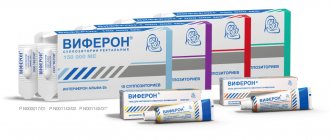Conjunctivitis is an eye disease characterized by inflammation of the inner lining of the eyelid. In ophthalmology, there are several types of this pathology. Children under 7 years of age suffer from conjunctivitis especially often. Let's consider the causes of each type, characteristic symptoms, and methods of treatment. What measures should be taken to prevent the disease?
Conjunctivitis in children is a common occurrence, especially in preschoolers, and this is understandable. The main ways of spreading the disease are airborne droplets and household contact. The level of personal hygiene in young children is very poorly developed. They often rub their eyes
In this article
- Viral conjunctivitis
- Herpetic conjunctivitis
- Viral conjunctivitis in a child: symptoms
- Treatment of viral conjunctivitis in children
- Bacterial conjunctivitis in a child
- Symptoms of bacterial conjunctivitis
- The dangers of viral and bacterial conjunctivitis
- Allergic conjunctivitis in a child
- Rules of child hygiene in the treatment of conjunctivitis
- Prevention of conjunctivitis
dirty fingers, biting nails, and this is a direct path for infection. As soon as one child gets sick, the disease begins to spread quite quickly in the children's group. The children share toys and other objects and can dry their hands with the same towel. Let's look at the types of conjunctivitis in children.
Viral conjunctivitis
This type of disease develops when various viruses enter the child’s body. The most common of them are adenoviruses, which are the causative agents of many ailments: influenza, ARVI, acute respiratory infections and others. When infected with adenoviruses 3, 4 and 7 serotypes, acute pharyngoconjunctivitis develops. Viruses 8 and 10 serotypes cause epidemic keratoconjunctivitis. Many adenoviruses cause the development of upper respiratory tract infections: tonsillitis, pharyngitis, rhinitis and other diseases. Adenoviruses are very tenacious. They can remain active on various surfaces for up to 7-10 days. As soon as a child picks up a dusty or dirty object and then touches the mucous membrane, the virus enters the body, provoking the development of the disease. Children under 6-7 years of age are especially susceptible to the effects of adenoviruses. Their immune system is still very weak and cannot resist infections to the same extent as an adult body. According to statistics, adenovirus infection in children under six years of age accounts for up to 30% of cases of all viral illnesses.
Viral conjunctivitis in a child can occur as an independent pathology or develop against the background of illnesses caused by viruses: influenza, acute respiratory viral infections, acute respiratory infections, nasopharyngitis and other diseases of the upper respiratory tract. In such cases, complex treatment is prescribed.
Herpetic conjunctivitis
The herpes simplex virus is also a common cause of inflammation of the conjunctiva. It can provoke various types of herpetic conjunctivitis:
- catarrhal, which is characterized by mucous or purulent discharge from the eyes;
- follicular, in which vesicles with liquid content appear on the conjunctiva and eyelids - follicles;
- The vesicular-ulcerative type of the disease occurs with the formation of erosions or ulcers covered with films, often accompanied by the formation of dense nodules.
The herpes virus, once entering the body, is integrated into the DNA of the trigeminal ganglion, and a person lives with it all his life. From 60 to 90% of all people are carriers of the herpes simplex virus. However, in the normal state of the body, it does not bother the owner. But in certain situations, for example, a weakened immune system, hypothermia, vitamin deficiency, or after previous infections, the herpes virus is activated, provoking the development of inflammatory diseases: the well-known “cold” on the lips or conjunctivitis.
Viral conjunctivitis in a child: symptoms
After the virus begins to act, the sick child shows signs of illness:
- lacrimation, swelling and hyperemia of the eyelids;
- feeling of “sand” in the eyes, pain, dryness, rejection of bright light;
- mucous discharge;
- weakness and lethargy in the muscles;
- deterioration of sleep and appetite.
If such symptoms appear, parents should call a doctor at home to examine the child. The sooner treatment begins, the faster the body will cope with the disease. In addition, sometimes bacterial conjunctivitis can be accompanied by viral conjunctivitis, accompanied by purulent discharge from the eyes, swollen lymph nodes and other unpleasant manifestations. It will be more difficult to cure the disease in this situation.
Conjunctivitis in children
Conjunctivitis in a child can occur in isolation; in some cases the ocular symptoms are preceded by catarrhal symptoms. With conjunctivitis of any etiology, children develop a symptom complex, including swelling of the eyelids, conjunctival hyperemia, increased lacrimation, fear of light, foreign body sensation or pain in the eyes, blepharospasm.
In children, an eye infection can be suspected even before clinically significant manifestations appear due to restless behavior, frequent crying, and constant attempts to rub their eyes with their fists. With isolated conjunctivitis in children, the body temperature is usually normal or subfebrile; in case of general infection it can rise to high values.
Due to the thickening of the conjunctiva and its injection by blood vessels during the disease, visual function is slightly reduced. This deterioration is temporary and reversible: with adequate treatment of conjunctivitis, vision is restored immediately after the children recover.
Bacterial conjunctivitis in children
With conjunctivitis of bacterial etiology, eye damage is bilateral, often sequential - first the infection manifests itself in one eye, and after 1-3 days the other eye is affected. A typical sign of bacterial conjunctivitis in children is mucopurulent or viscous purulent discharge from the conjunctival cavity, sticking of the eyelids, and drying of crusts on the eyelashes. The color of the conjunctival discharge can vary from light yellow to yellow-green.
The course of bacterial conjunctivitis in children can be complicated by blepharitis and keratoconjunctivitis. Deep keratitis and corneal ulcers develop rarely, mainly against the background of a general weakening of the body - hypovitaminosis, anemia, malnutrition, bronchoadenitis, etc.
Gonoblenorrhea of newborns develops 2-3 days after birth. Symptoms of conjunctivitis of gonorrheal etiology are characterized by dense swelling of the eyelids, bluish-purple coloration of the skin, infiltration and hyperemia of the conjunctiva, serous-hemorrhagic, and then profuse purulent discharge. The danger of gonococcal conjunctivitis in children lies in the high likelihood of developing purulent infiltrates and corneal ulcers that are prone to perforation. This can lead to the formation of a cataract, a sharp decrease in vision or blindness; when infection penetrates into the internal parts of the eye - endophthalmitis or panophthalmitis occurs.
Chlamydial conjunctivitis in children develops 5-10 days after birth. At older ages, infection can occur in closed reservoirs, and therefore outbreaks of the disease in children are often referred to as basin conjunctivitis. The clinical picture is characterized by hyperemia and infiltration of the mucous membrane of the eyelids, ptosis of the eyelids, the presence of abundant liquid purulent secretion in the conjunctival cavity, and hypertrophy of the papillae. In children, extraocular manifestations of infection are often possible: pharyngitis, otitis, pneumonia, vulvovaginitis.
Diphtheria conjunctivitis usually develops against the background of diphtheria of the pharynx, mainly in children under 4 years of age. It should be noted that currently, thanks to mandatory vaccination of children against diphtheria, isolated cases of infection are observed. Eye damage is characterized by painful swelling and hardening of the eyelids, which, when opened, release a cloudy serous-hemorrhagic secretion. Gray, difficult to remove films are visible on the surface of the conjunctiva; after their removal, the bleeding surface is exposed. Complications of diphtheria conjunctivitis in children may include infiltrates and ulcerations of the cornea, clouding of the cornea, perforation of the ulcer and death of the eye.
Viral conjunctivitis in children
Viral conjunctivitis in children usually accompanies the course of ARVI, and is therefore characterized by a temperature reaction and catarrhal symptoms. In this case, the involvement of the eyes in inflammation occurs sequentially. Viral conjunctivitis in children is characterized by copious, liquid, watery discharge from the conjunctival sac, giving the impression of constant lacrimation.
With herpetic conjunctivitis in children, rashes in the form of blisters may be found on the skin of the eyelids and conjunctiva; with measles conjunctivitis - a measles-like rash; with chickenpox - smallpox pustules, which, after opening, turn into scars. Sometimes viral conjunctivitis in children is complicated by the addition of a secondary bacterial infection, which is accompanied by the appearance of purulent discharge from the eyes.
Treatment of viral conjunctivitis in children
To eliminate the symptoms of viral pathologies, drugs with interferon are used. They fight viruses, alleviate the symptoms of the disease and improve their general condition. Antiviral ointments complement the main course of therapy well. It is important that the prescribed drug affects exactly the pathogen that provoked the disease. In this case, the choice of medications depends on the age of the child. The standard method of treating conjunctivitis of viral etiology is drops and ointments. To eliminate symptoms, the drugs “Actipol”, “Oftan Idu”, “Oftalmoferon”, “Oftan”, “Sodium Sulfacyl”, “Vitabakt”, “Levomycetin”, “Tobrex”, “Floxal” and others can be prescribed. For the herpetic form of the disease, Florenal, Zovirax, Virolex and others drops are used.
If the virus has also affected the skin around the eyes, then Acyclovir and Valtrex ointments may be additionally prescribed. To avoid the addition of a bacterial infection, tetracycline or erythromycin ointments and antibiotic eye drops are additionally used.
Drops for conjunctivitis in children: list of effective remedies
For viral conjunctivitis
Oftalmoferon (eye drops)
The advantage of the drug is the successful combination of human recombinant interferon 2-alpha and diphenhydramine. Thus, the use of the drug achieves antiviral and antihistamine effects. This allows you to both influence the viral agent and reduce the severity of inflammatory tissue edema.
The concentration of the main components remains high only within the conjunctival cavity, which is why many recommend it for newborns and infants. Relieves itching well. The drug is effective for adenoviral, herpetic diseases and conjunctivitis caused by other viruses.
For infants, as well as for older children, it is reasonable to start using it within the first or second day from the appearance of the first signs of the disease. The instillation mode is as follows. Up to 8 times a day (every waking hour), 1 drop into each conjunctival cavity. Drip for 5 days.
The disadvantage is that when instilled, the child may complain that the drug burns. The burning sensation is minor. If you blink well, it goes away.
The drug is not recommended for use in dry eye syndrome. So its effectiveness in treating viral forms decreases in direct proportion.
Side effect: development of allergy symptoms due to sensitivity to the substances that form the basis of the drug.
Oftalmoferon
Aktipol (eye drops)
Advantage: contains para-aminobenzoic acid, which stimulates the synthesis of its own interferon. Provides antiviral protection, removes swelling and accelerates healing processes in the cornea.
For children under one year of age and newborns, it is recommended to use this drug for no more than a week according to the following scheme: 1 drop of the drug is dripped into both conjunctival cavities 8 times a day.
It is possible to develop allergic reactions to the components that make up the drug. An opened bottle should be stored for no more than 3 weeks.
Aktipol
Oftan I'm coming
Antiviral eye drops for children over 2 years of age.
Advantage: contains idoxuridine, which has an antiherpes effect.
The disadvantage is the application regimen, which has its own characteristics and is controlled exclusively by an ophthalmologist.
The drug begins to be dripped into the conjunctival cavity of the affected eye, 1 drop hourly during the day and every 2 hours at night until the condition stabilizes. Then instill 1 drop every hour during the day and every 3 hours at night. Drops should be continued to be instilled for 3 to 4 days after recovery to consolidate the effect. The drug should not be used for more than 3 weeks.
Contraindications: this medicine should not be prescribed for deep corneal erosions. Its components significantly slow down the regeneration processes.
Adverse reactions may occur : itching, pain, fear of light, superficial erosions of the cornea. Allergic reactions may develop to the components of the drops. Everything goes away, you just have to stop using the drug.
Oftan I'm coming
Zovirax ointment
The active ingredient is acyclovir. It has an active antiviral effect on herpesvirus, cytomegalovirus and chickenpox conjunctivitis.
Application: ointment for newborns is applied in the form of a small pea. Infants and older children up to 1 centimeter long.
Use for another 3 days after achieving the desired clinical effect.
Features of the drug: when applying the ointment, there is a burning sensation, which goes away on its own after a minute.
The main side effect is the development of allergic manifestations in persons with hypersensitivity to the components.
Zovirax ointment
For bacterial conjunctivitis
Sulfacyl sodium (eye drops)
The most popular sulfonamide drug contains sodium sulfacetamide monohydrate (albucid). Does not lose its rightful place in the effective treatment of bacterial conjunctivitis.
Use 30% sodium sulfacyl for newborns to prevent gonoblenorea. Application: 1 drop into the conjunctival cavity of each eye once.
The main advantage of the drug is that both “children’s” 10% sodium sulfacyl and “adult” 20% sodium sulfacyl are actively used both for newborns and for the treatment of bacterial conjunctivitis in young children.
Application: 1 drop into the conjunctival cavity of each eye. Up to 6 times a day for at least 10 days.
Features of the drug: instillation of 10% sodium sulfacyl causes a weaker burning sensation compared to 20% sodium sulfacyl.
Side effects: burning, itching, lacrimation. They disappear after active blinking. If allergic reactions occur, you should cancel the instillation and consult an ophthalmologist.
Store the opened bottle for no longer than 1 month.
Sulfacyl sodium
Tobrex
Advantage. Tobramycin has an antimicrobial effect. The drug is the first line of reserve in persons with allergic manifestations to fluoroquinolones.
Used as a treatment for inflammatory diseases, as well as an alternative to 30% sodium sulfacyl as eye drops for newborns.
Although these drops were not positioned as children’s drops for a long time, their effectiveness and safety when prescribed to newborns and infants was proven.
For infants and young children, use the following regimen: 1 drop in both eyes for no longer than 1 week. Adults are allowed to prescribe for up to 24 days, with a mandatory change of drug if the condition worsens.
The occurrence of any allergic reaction is considered a side effect of the drug.
Overdose is possible. If tinnitus or urinary problems occur, stop using the drug.
It is worth checking the name of the drug with special attention. It can be easily confused with the drug Tobradex, which contains a glucocorticoid and is excluded for use in young children.
Tobrex
Erythromycin (1% ophthalmic ointment)
Antibacterial drug, macrolide, the main active ingredient is erythromycin.
Used for conjunctivitis that is difficult to treat (gonococcal, chlamydial, tuberculosis, fungal, diphtheria and others).
It is used once as an ointment for newborns in the absence of 30% sodium sulfacyl.
Features: used in children with severe intolerance to penicillin-containing drugs.
Apply after instillation of all drops. The ointment is applied to both eyes 3 times a day for 10 days.
The drug is combined with other antibacterial agents due to the fact that bacterial agents develop resistance to erythromycin too quickly.
The development of any manifestations of allergies is considered a side effect.
Erythromycin
Floxal eye drops
Advantage: fluoroquinolone antibacterial drops are considered one of the fastest-acting.
The disadvantage is that, despite the instructions, it is not recommended to use Floxal in young children due to the frequent development of adverse reactions and the formation of resistance to antibacterial agents of this group.
For children over 7 years of age, the dosage is as follows: 1 drop in both eyes 5 times a day for 10 days. The appearance of photophobia, swelling of the eyelids, itching and lacrimation is an adverse reaction to the drug.
For allergic conjunctivitis
The prescription of drugs is purely symptomatic treatment. To achieve a lasting effect, you must find the allergen and eliminate it.
Bacterial conjunctivitis in a child
This form of the disease is caused by various pathogenic microorganisms: staphylococci, streptococci, Pseudomonas aeruginosa, etc. Young children have poor personal hygiene: they rub their eyes with dirty hands, eat unwashed fruits or vegetables that may have germs on them. Infection often occurs when swimming in ponds or pools, or using shared towels or bed linen. Conjunctivitis can develop with diseases of the nasopharynx (sinusitis, rhinitis, tonsillitis). When you sneeze, bacteria from your nose and throat enter your eyes, causing inflammation. It is not for nothing that it is recommended to wear protective masks for diseases of the upper respiratory tract. Even a newborn baby can suffer from bacterial conjunctivitis if it becomes infected through a woman’s birth canal. A particularly severe course of the disease in an infant is caused by gonococci and chlamydia.
Symptoms of bacterial conjunctivitis
A characteristic sign of this pathology, in addition to swelling and hyperemia of the eyelids, is profuse purulent discharge from the eyes, which sticks the child’s eyelashes together after sleep. Corneal ulceration, increased body temperature, and deterioration in vision clarity may also occur. Before administering drops or ointments when treating bacterial conjunctivitis, it is necessary to pre-wash the child's eyes. To do this, you can use a weak solution of boric acid, furatsilin tablets dissolved in clean water, or a special preparation “Blefarolion” from the Russian one.
Before starting the procedures, you need to wash your hands well so as not to get dirt into your eyes. It is advisable to rinse several times a day to eliminate traces of purulent discharge. To treat bacterial conjunctivitis, medications with antibiotics are prescribed, which are not absorbed into the blood, but act only on the eye structures, and therefore are safe for children. This therapy helps to quickly eliminate the symptoms of the disease. In this situation, the following drugs can be used: Sulfacyl sodium, Vitabact, Levomycetin, Tobrex, Floxal and others. If after 2-3 days there is no improvement, then you need to contact an ophthalmologist - he will prescribe another medicine.
For bacterial conjunctivitis
Coccal flora is the most common cause of bacterial inflammation. This type is widespread in children, because bacteria easily penetrate the visual organ when rubbing the eyelids with dirty hands. A characteristic symptom is profuse yellow or green discharge from the baby's eyes.
For bacterial conjunctivitis, antibacterial drops with a wide range of effects are prescribed. This is due to the fact that bacterial culture of the discharge is performed for at least 7 days, and treatment must be started as early as possible. The course of treatment is 7–10 days.
Albucid
“Sulfacyl sodium” (“Albucid”) - cheap drops for conjunctivitis, suitable for newborns and older children. Albucid drops for children help against purulent conjunctivitis. The drug is instilled into newborns immediately after birth and 2 hours later. Apply drops with a concentration of the active substance of 10%. Instill 4–6 times a day. A transient burning sensation may occur. “Albucid” costs no more than 50 rubles.
Tobrex
Eye drops with the antibiotic tobramycin, used for conjunctivitis in children of all ages. At first, after the drug appeared, there were age restrictions. But later the safety of Tobrex was proven in the treatment of newborns and infants. For children, the course of therapy is limited to one week. The frequency depends on the severity of the manifestation, but not more than 5 times a day. Price 180-200 rubles.
Phloxal
The use of Floxal drops for bacterial conjunctivitis is approved for children of all ages. The positive effect of "Floxal" is achieved quickly. Instill 2–4 times a day. Treatment will cost 150-200 rubles.
Levomycetin
Inexpensive, effective drops with a wide spectrum of antimicrobial activity. Most bacteria are sensitive to Levomycetin and do not have resistance. Recommended from 1 month of life, 1 k. 3 times a day. Without consulting a doctor, the course of therapy should be no more than 3 days. Drops cost from 10 rubles.
Fucithalmic
The drops have a thick consistency. This allows it to remain on the surface of the visual organ for a long time and have an antimicrobial effect. Application twice daily is sufficient. "Fucitalmic" is approved for children of all ages. Costs from 400 rub.
Video: Fucithalmic - indications for use
Vitabact
Antiseptic with antimicrobial action. Can be used as a prophylactic after eye contamination. "Vitabact" is suitable from the neonatal period. Multiplicity: 2–6 times/day. Price from 300 rub.
Ciprofloxacin
Allowed from 1 year. "Ciprofloxacin" has analogues: "Ciloxan", "Cipropharm", "Floximed". Instill every 4 hours. The cost starts from 15 rubles.
The dangers of viral and bacterial conjunctivitis
These types of eye pathologies pose the greatest danger to the child’s health. They tend to take an epidemic course, quickly spreading in children's groups through the air and household contacts: shared toys, hygiene items, dishes, etc. In the event of an epidemic of conjunctivitis, quarantine is declared for a period of 10-14 days. At the same time, if possible, it is better to limit visits to kindergarten so as not to expose the child to infection. Inside the premises of the child care facility, a complete sanitary and hygienic treatment is carried out to ensure that all surfaces are as safe as possible. Some types of viruses can survive on them for up to 7-10 days.
Allergic conjunctivitis in a child
This form of conjunctivitis is individual and is not transmitted through contact or air. Various allergens can cause eye irritation:
- pollen of flowering plants;
- animal wool and fluff;
- products, medicines;
- household chemicals, etc.
As soon as a specific allergen hits the child’s mucous membranes, the body immediately begins to react to it. The eyes become inflamed and red, itching, lacrimation, swelling of the nose and eyelids, photophobia, and cough appear. Here are the factors that can cause this pathology.
- Hay fever, or seasonal allergic rhinoconjunctivitis. Occurs in spring and summer when some plants bloom. With hay fever, allergic dermatitis can develop, and it is also characterized by increased fatigue and weakness. Antihistamines are prescribed for treatment, supplemented with corticosteroids in severe cases.
- Drug-induced conjunctivitis. Occurs while taking any medications. Standard signs of allergies may also include skin rashes and severe swelling of the nasal mucosa. If this form of conjunctivitis appears in a child, you should immediately stop taking medications and contact an ophthalmologist to clarify the circumstances.
- Chronic allergies. This disease can accompany a person throughout his life, as it manifests itself on any of the most common components: house dust, animal hair, cosmetics, etc. An irritant reaction can occur at any time upon contact with an allergen. After eliminating the irritant, the symptoms disappear.
For the treatment of allergic conjunctivitis, small children are prescribed drops that relieve swelling and irritation, for example, Vizin, as well as antihistamines Allergodil, Alezastin, Olopatadine. They help reduce the manifestations of the disease.
Please note that all medications must be used strictly as prescribed by an ophthalmologist.
If they are suitable, the symptoms will begin to subside on the second or third day. If this does not happen, consult a doctor - he will prescribe another remedy.
Drops and ointments for allergic conjunctivitis in children
Many babies have reactions to a wide variety of allergens: from dust to flowering plants. Eye drops and ointments will help cope with unpleasant symptoms.
List of drops and ointments for allergic conjunctivitis in children
| Name | Minimum age allowed for use |
| Allergodil drops | From 4 years old |
| Cromohexal drops | From 2 years (with caution up to 4 years) |
| Lecrolin drops | From 4 years old |
| Opatanol drops | From 3 years |
| Hydrocortisone ointment | From 2 years |
Below are brief instructions for using drops for allergic conjunctivitis in children.
Allergodil
- Manufacturer: Meda Pharma (Germany).
- Analogues of the drug are: Tizin Allergy, Rhinital, Cromoglin.
The blocker of H1-histamine receptors responsible for the development of allergies is a phthalazinone derivative, azelastine.
Drops are prescribed to children over 4 years of age, instilling 1 drop into each eye in the morning and evening. If necessary, the frequency of administration is increased to 4 times a day.
Local adverse reactions include burning and blurred vision, and occasionally a bitter taste in the mouth, headaches, fatigue, itching, asthma, dipnea, and allergic reactions.
Cromohexal
- Cromohexal is produced by the following companies: Sandoz d.d. (Slovenia) and Aeropharm Gmbh (Germany).
- The most common analogues of the drug are: Cromolyn, Vividrin, Ifiral, Intal, Thaleum, Cromogen and others.
Sodium cromoglycate, the active component of the drug, has proven itself as an effective antiallergic agent.
It is used from 2 years of age (up to 4 years of age - with caution). It is necessary to instill 1-2 drops of Cromohexal 4 times a day, maintaining an interval between instillations of 4-6 hours. If necessary, the number of injections is increased to 6-8 times.
Side effects include a burning sensation, dry eyes, blurred vision, swelling of the conjunctiva, lacrimation, styes, and the sensation of a foreign object in the eye.
Video advice from an ophthalmologist on instilling eye drops
Lecrolin
- The drug is produced (Finland).
- Analogs of Lecrolin include: Cromogen, Cromohexal, Allergo-Komod, Intal, Krom-Allerg, High-Krom, Vividrin and others.
The active component of the drops is cromoglycic acid, which prevents the development of allergies.
It is acceptable to use them in children over 4 years of age, instilling 1-2 drops into the conjunctival cavity every 4-6 hours until there are no signs of allergy.
Among the adverse reactions, the most common are burning, temporary problems with visual perception, swelling of the conjunctiva, the development of barley, dry eye syndrome, lacrimation, swelling of the conjunctiva, and the sensation of a foreign object in the eye.
Opatanol
- Drops are produced (Russia).
- Opatanol has analogues: Visallergol and Olopatallerg.
The active component, olopatadine, is a selective inhibitor of H1-histamine receptors responsible for allergic conditions.
Opatanol is used in children over 3 years of age, instilling 1 drop 2 times a day (with an interval of at least 8 hours).
The most common side effects include severe burning and pain in the eyes, dry cornea, sensation of a foreign object in the eye, and temporary visual disturbances. Occasionally, there are reports of headaches, dizziness, weakness, and dryness of the nasal mucosa during treatment.
Ointments with hydrocortisone
- When the first symptoms of an allergy appear, ointments based on hydrocortisone, a hormone contained in the adrenal cortex, also turn out to be very effective: Laticort, Hyoxysone, Ascortin, Cortade, Lokoid Lipokrem.
- Manufacturers of hydrocortisone ointment: Tatkhimfarmpreparaty, JSC Murom Instrument-Making (Russia), PJSC Farmak (Ukraine), Jelfa SA (Poland), Ursafarm Arzneimittel GmbH (Germany), Hemofarm (Serbia).
Preparations based on hydrocortisone reduce the body's sensitivity to allergens. Hydrocortisone ointment is used in children over 2 years of age. A strip of ointment 1-1.5 cm long is placed behind the lower eyelid at least 3 times a day.
The various side effects of the drug are very extensive and include redness of the sclera, burning, and in severe cases - eczema of the eyelids, exophthalmos, cataracts, secondary glaucoma of steroid origin, and corneal perforation.
Rules of child hygiene in the treatment of conjunctivitis
It is very important to monitor the child’s personal hygiene during treatment - this will greatly help speed up recovery. Get him separate hygiene items: soap, a towel - it’s better if they are disposable. You should also change bed linen every day and wet-clean surfaces in the room with a disinfectant. During the treatment period, it is better to refrain from visiting public places, going to the pool, or sauna. In general, it is advisable to leave the child at home until complete recovery. It is worth removing sweet, spicy, salty foods from your diet and introducing into your daily menu more foods rich in vitamins A, B, C, selenium, zinc, which are good for eye health. Very often, the occurrence of infection is a consequence of a weakened immune system, so an enhanced vitamin course will help cope with the disease.
Make sure that your child does not spend a lot of time at the computer or with a gadget to prevent dryness and irritation of the eyes. A large percentage of success in treatment depends on compliance with these simple rules.
Prevention of conjunctivitis
Teach your child to wash vegetables and fruits thoroughly. Explain to him the importance of personal hygiene from an early age: why you need to wash your hands after returning from the street and before eating, use your own towel, and also do not bite your nails and fingers, and do not rub your eyes with dirty hands. If signs of illness appear, you should not look for advice on the Internet, but take your child to an ophthalmologist or call him at home. The external manifestations of various types of conjunctivitis are very similar, and only a specialist will establish the true etiology and prescribe an effective medicine. Self-selected medication may worsen the situation. 90% of success in the treatment of this eye pathology depends on timely contact with a specialist and strict adherence to all his recommendations.
The disease in an advanced stage can take a chronic course, and it will be much more difficult to cure it. In addition, some types of conjunctivitis in children can seriously affect the condition of their visual organs. Remember, our health largely depends on our attitude towards it.
Other medicines
To treat conjunctivitis in a child, drops, ointments, and tablets are used. When severe complications develop, injectable forms of drugs are used.
Other drugs for the treatment of conjunctivitis in children:
- Ointments. Bacterial conjunctivitis: “Erythromycin” from birth, “Tetracycline” from 8 years. Viral: “Oxolin” from 2 years. Allergic: glucocorticosteroid ointments are prohibited for self-medication and are prescribed only as prescribed by a doctor.
- Tablets for allergic conjunctivitis: “Zyrtec”, “Cetrin” are allowed from 6 months.
- Injection solutions against allergies are prescribed in extreme cases in a hospital setting: Prednisolone, Hydrocortisone, Diphenhydramine.










